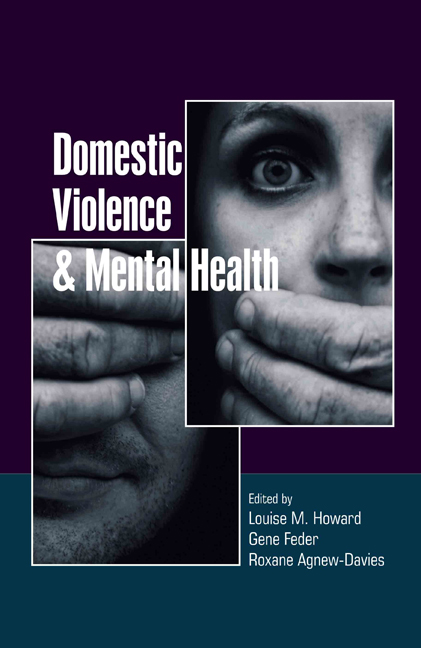Book contents
- Frontmatter
- Contents
- List of tables, boxes and figures
- List of contributors
- 1 Prevalence and physical health impact of domestic violence
- 2 Domestic violence and mental health
- 3 Identifying domestic violence experienced by mental health service users
- 4 Responding to disclosures of domestic violence
- 5 Interventions for mental health service users who experience domestic violence
- 6 Medico-legal issues
- Appendix 1 CAADA Risk Identification Checklist (RIC) and Quick Start Guidance for Domestic Abuse, Stalking and ‘Honour’-Based Violence
- Appendix 2 Domestic violence resources and directory of services
- Index
5 - Interventions for mental health service users who experience domestic violence
- Frontmatter
- Contents
- List of tables, boxes and figures
- List of contributors
- 1 Prevalence and physical health impact of domestic violence
- 2 Domestic violence and mental health
- 3 Identifying domestic violence experienced by mental health service users
- 4 Responding to disclosures of domestic violence
- 5 Interventions for mental health service users who experience domestic violence
- 6 Medico-legal issues
- Appendix 1 CAADA Risk Identification Checklist (RIC) and Quick Start Guidance for Domestic Abuse, Stalking and ‘Honour’-Based Violence
- Appendix 2 Domestic violence resources and directory of services
- Index
Summary
The current evidence base on interventions to support mental health service users who experience domestic violence is limited. Three systematic reviews have examined the evidence on the effectiveness of interventions in improving mental health outcomes and safety for victims in community and healthcare settings (Ramsay et al, 2002, 2009; World Health Organization & London School of Hygiene and Tropical Medicine, 2010). Existing interventions include individual and group psychological therapies, psychosocial support and advocacy programmes. The methodological quality of many of these studies, however, is low (owing to small sample sizes, lack of randomised controlled trial evidence, etc. – see Feder et al (2009) for details) and this limits the strength of evidence for these interventions. We summarise the more robust evidence, suggest good clinical practice based on our clinical experience and the international literature, and then provide recommendations on referral pathways for clinicians following patient disclosures of domestic violence victimisation. Although there is no reason to think that victims of domestic violence who have mental disorders will not benefit from evidence-based interventions for those disorders, clinical interventions may not be as effective if domestic violence is not addressed. There is a striking lack of evidence on this issue, so this chapter focuses on the evidence for psychiatric interventions that do also address domestic violence.
Psychological interventions
Evidence-based psychological interventions should be implemented within care planning. However, well-evidenced interventions such as cognitive– behavioural therapy (CBT) and lower intensity interventions including guided self-help seem unlikely to improve outcomes for mental health patients with a history of domestic violence unless they address the abuse experienced, both by assessing risk and promoting patient safety, but also by direct acknowledgement of the psychological impact of abuse in the therapy itself. More research is needed to help guide psychological treatments for victims of violence (Nicolaidis, 2011), but clearly, therapists need to ask about and explore the acute and chronic effects of violence on their patients. It is worth remembering that the formation and maintenance of a therapeutic relationship will be more complex and subjected to greater challenges than usual if the patient is or has been a victim of domestic violence (Wilson & Lindy, 1994; Turner et al, 1996; Herman, 1998), because the interpersonal aspects of the trauma, such as mistrust, betrayal, dependency, love and hate tend to be replayed within the therapeutic dyad.
- Type
- Chapter
- Information
- Domestic Violence and Mental Health , pp. 64 - 77Publisher: Royal College of PsychiatristsFirst published in: 2017

